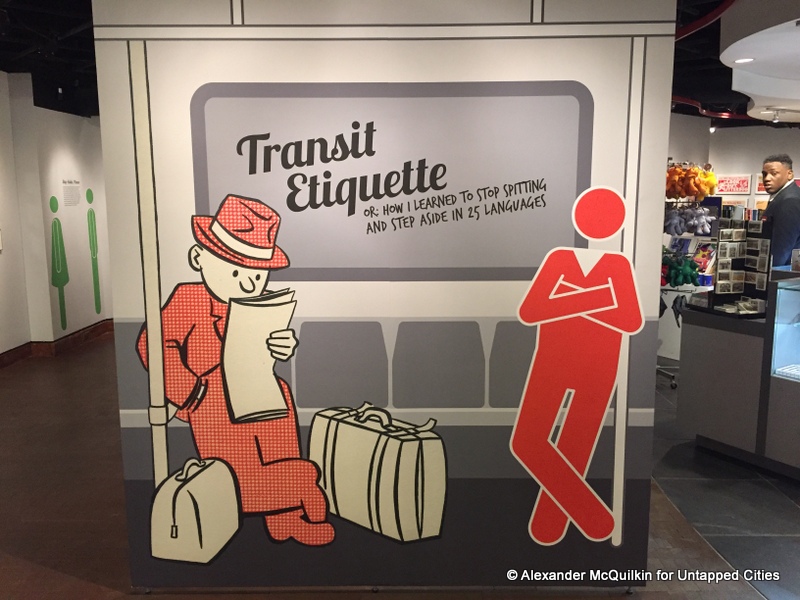
This past Saturday, the New York Transit Museum opened its latest exhibition, Transit Etiquette or: How I Learned To Stop Spitting and Step Aside in 25 Languages at its Gallery Annex at Grand Central Terminal. The exhibition features over 100 years of posters from around the world calling on transit riders to refrain from littering, give up a seat to the elderly, and step aside for exiting passengers, among many other transit niceties.
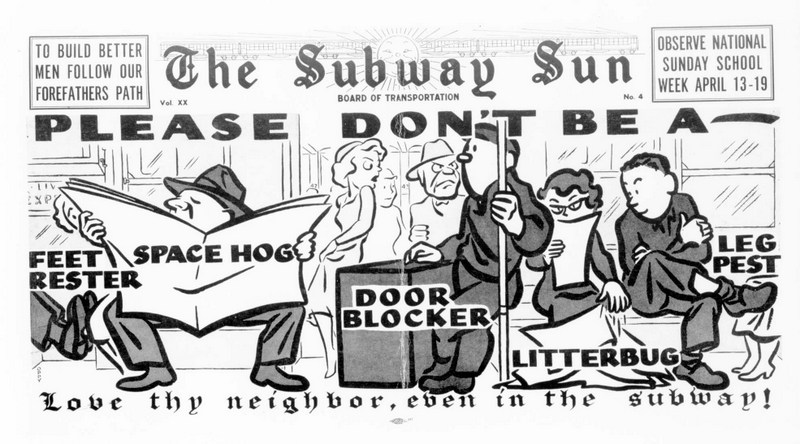 Images via the New York Transit Museum Collection
Images via the New York Transit Museum Collection
The show is organized by “transit etiquette sin,” starting with “Be a Space Saver” and ending with “This is Your Train, Take Care of it,” and features transit etiquette artwork from Barcelona, Brussels, Chicago, London, Madrid, Philadelphia, Rio de Janeiro, Taipei, Tokyo, and of course New York City. One of the most remarkable observations is that behind the eye-catching graphics, the message is essentially the same throughout history and across languages. It seems that a) we haven’t learned to be more polite on our commutes through the generations and b) transit transgressions aren’t limited to any particular culture or geography.
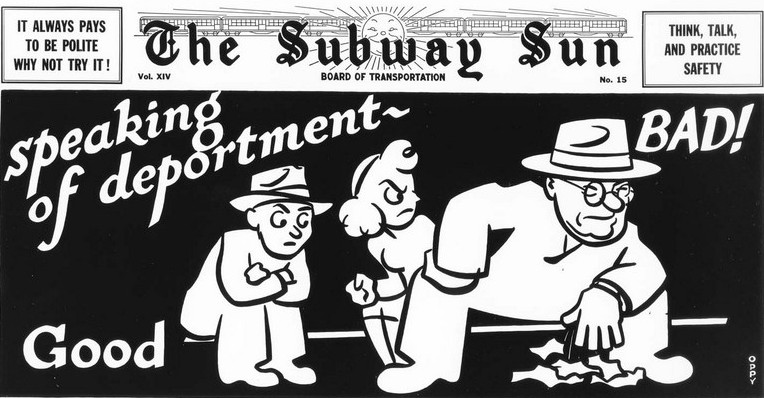 These “Subway Sun” posters, designed by Amelia Opdyke Jones for the New York City Subway were in use for over 40 years beginning in 1918. Images via the New York Transit Museum Collection
These “Subway Sun” posters, designed by Amelia Opdyke Jones for the New York City Subway were in use for over 40 years beginning in 1918. Images via the New York Transit Museum Collection
But there are some signs of the times. Early commuters weren’t used to being confined in small places underground. So smoking and spitting were big problems, as evidenced by Amelia Opdyke Jones’s silly newspaper-like poster series utilized in the New York City subway from 1918 into the 1960s. Like most of the posters on view here, Jones tries to use humor to cajole commuters to behave themselves.
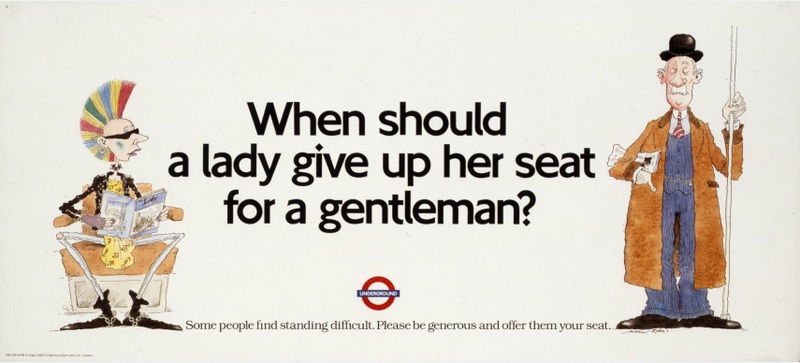 This 1980s poster for the London Underground tries to keep up with the times
This 1980s poster for the London Underground tries to keep up with the times
Image via TfL from the London Transport Museum collection
Today, riders of the New York City subway will see signs forbidding the use of hoverboards on the system, a gadget that was certainly not around half a century ago. But Todd Gilbert, the New York Transit Museum’s registrar, thinks there are more than a few parallels between the classic work of Jones and the MTA’s latest “Courtesy Counts” transit etiquette campaign. And if media coverage and internet chatter are any measure, “Courtesy Counts” has been a huge success.

 Humor seems to be an overriding theme, like in this series for Vancouver TransLink Images via TransLink
Humor seems to be an overriding theme, like in this series for Vancouver TransLink Images via TransLink
Last year the Oxford English Dictionary included for the first time a definition for manspreading: “the practice whereby a man, especially one travelling on public transport, adopts a sitting position with his legs wide apart, in such a way as to encroach on an adjacent seat or seats.” The term went viral following the rollout of MTA’s campaign, despite the fact that the agency didn’t coin the phrase and its posters didn’t actually feature it. Merely reading “Dude, Stop the Spread,” the posters avoid explicit mention of any gender, while implying what most riders already understand – that men are the chief offenders.
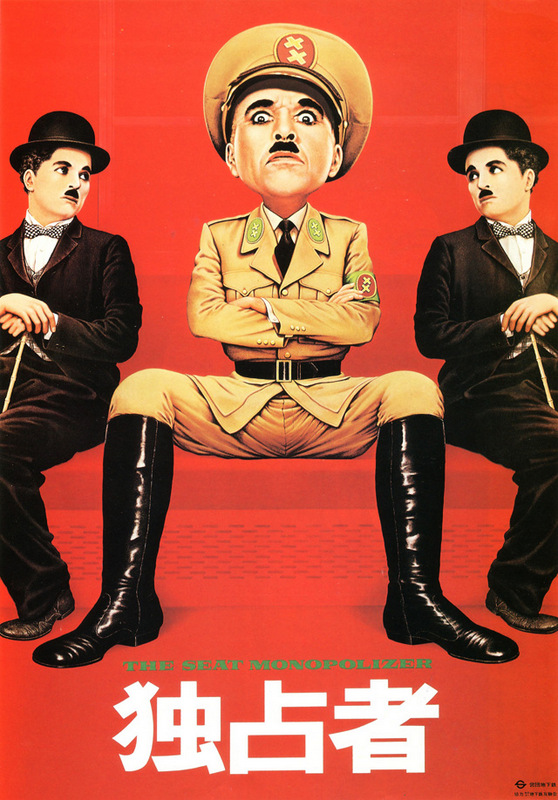 Hideya Kawakita designed a poster series featuring pop icons like Charlie Chaplin for the Tokyo Subway in the 1970s
Hideya Kawakita designed a poster series featuring pop icons like Charlie Chaplin for the Tokyo Subway in the 1970s
Image via Tokyo Metro Cultural Foundation
Proof that manspreading is no new phenomenon is a 1970s poster designed by Hideya Kawakita for the Tokyo Subway showing a Hitler-esque man seated in a wide stance with the caption “The Seat Monopolizer.” Kawakita famously featured pop culture icons in his transit posters, including Marilyn Monroe, Charlie Chaplin and Santa Claus. His are probably the most visually arresting of the advertisements on display here, even if their intended message isn’t always so obvious.
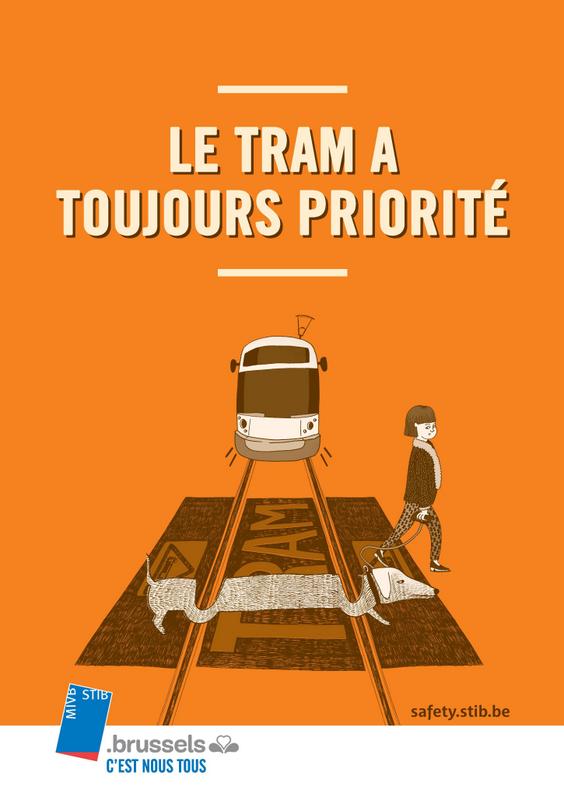 Good graphics make captions (“The tram always has priority”) almost unnecessary
Good graphics make captions (“The tram always has priority”) almost unnecessary
Image via Brussels Intercommunal Transport Company and Mortierbrigade SA with permission of David P. Favest
If the messages seem redundant (no noise, no litter, no space hogging, no door-blocking), well, that’s the point. Transit etiquette, and the lack thereof, is a universal language. Now if we could just make the show required visiting for all 11 million of New York City’s daily commuters.
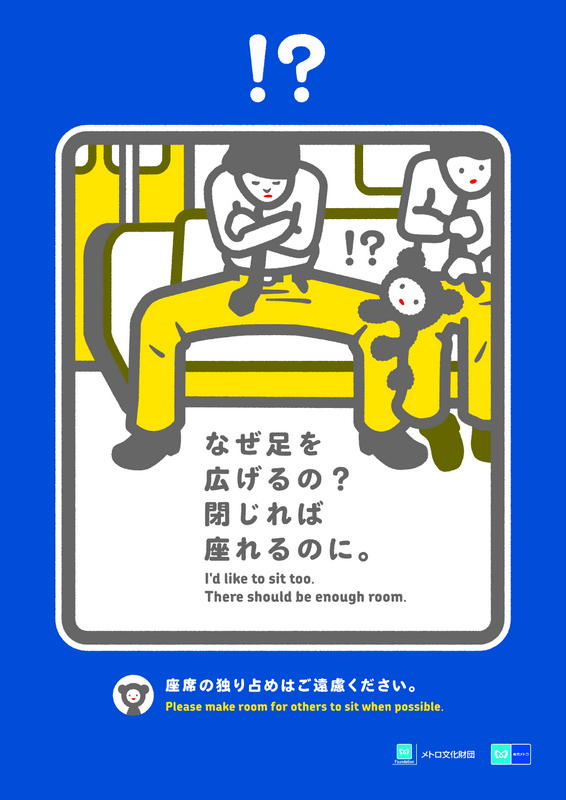 Apparently manspreading isn’t just a problem for New York City MTA
Apparently manspreading isn’t just a problem for New York City MTA
Image via Tokyo Metro Cultural Foundation
 New Yorkers will recognize the “Courtesy Counts” poster series, in use on New York City subways and buses since 2014
New Yorkers will recognize the “Courtesy Counts” poster series, in use on New York City subways and buses since 2014
Image via New York Transit Museum Collection
Transit Etiquette or: How I Learned To Stop Spitting and Step Aside in 25 Languages will be on display at the New York Transit Museum Gallery Annex at Grand Central Terminal through July 10. The annex is open Monday – Friday, 8am to 8pm and Saturday and Sunday, 10am to 6pm.
Next, check out the Top 10 Secrets of the NYC Subway. Get advance notice about our upcoming tour of the past, present and future of the NYC subway





